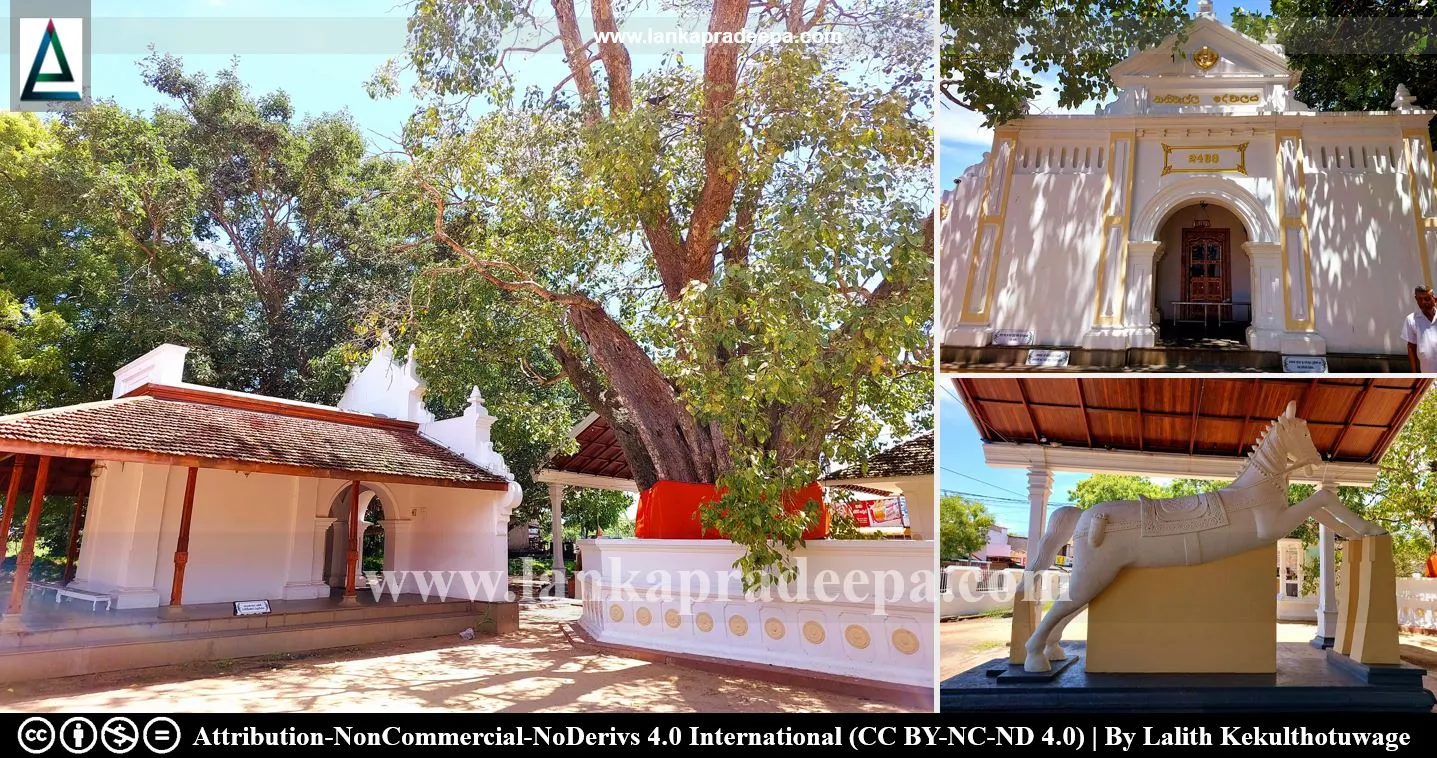
|
The Bodhit tree, facade and the white horse on Thaniwalla Devalaya premises |
Thaniwella Devalaya (Sinhala: මාදම්පේ තනිවැල්ල දේවාලය) is a Devalaya Shrine situated on the western edge of Maha Wewa (or Kudupity Wewa or Thinapitiya Wewa) in Madampe in Puttalam District, Sri Lanka. It has been dedicated to God Thaniya Wallabha (or Thaniwelle Bandara Deviyo), a local deity worshipped only in the Madampe area.
History
Madampe was a Gabadagama in the late 15th and early 16th century A.D. and Thaniya Wallabha (also known as Thaniyavallabahu), a son of King Vira Parakramabahu VIII (1490-1509 A.D.) of Kotte transformed the area into a semi-independent principality (Bell, 1920; De Silva, 1971; Suraweera, 1997). Several historical sources such as Rajavaliya and Alakeshwara Yuddhaya (The Battle of Alakeshwara) reveal that Prince Thaniya Wallabha reigned the principality of Katupity Madampe while his brother Sakalakala Wallabha lived in the Udugampola area [(read the article: Udugampola Ancient Pond) Bell, 1920; Suraweera, 1997]. He with his brother at Udugampola once expelled a Southern Indian Moor who engaged in business in the northwest of the country (Bell, 1920). Thaniya Wallabha built a palace for himself on a small hillock near the modern Madampe town and the area was held by his descendants for two further generations (De Silva, 1971). Thaniya Wallabha's grandson, Vidiya Bandara eventually inherited Madampe and rose to great power by marriage to the daughter of King Buvanekabahu VII (1521-1550 A.D.) of Kotte (De Silva, 1971).
It is not known how or when Thaniya Wallabha died and there are a few stories regarding his death (Bell, 1920). E. T. Noyes, a former Assistant Government Agent of Chilaw mentions a tradition existing in the Chilaw District that he committed suicide (Bell, 1920). One story states that when King Thaniya Wallabha went to a battle against a Moor, a minister falsely informed his queen that Thaniya Wallabha killed himself after losing the battle. It is said that the saddened queen jumped into the Kudupity Wewa nearby and committed suicide. The story tells that Thaniya Wallabha, who returned after winning the war, also committed suicide after hearing the fate of his queen.
Sir James Emerson Tennent (b.1804-d.1869) in his publication in 1860 records that there was an altar under a large banyan tree on the side of the highway, near the village of Madampe for Tannavilla Abhaya [(most probably Thaniya Wallabha) Tennent, 1860]. He further mentions that Tannavilla Abhaya was a chief who ruled over the district, under the title of King of Madampe and he died by his own hand (Tennent, 1860). However, in gratitude for his services, the people in the area have started to worship him as the tutelary deity of the place (Tennent, 1860).
As mentioned on the wall, the present shrine dedicated to God Thaniya Wallabha has been built at the site in 2438 B.E. (or 1894 A.D.). The Bodhi tree (Ficus religiosa) at the site is considered more than a hundred years old and now it is protected as an archaeological monument. Also, a Madan tree (Syzygium cumini) at the premises has been protected as an old tree associated with Prince Thaniya Wallabha.
A protected site
The Bodhi tree and its surrounding premises of Thaniwella Devalaya situated in Mahabaddegama village in the Madampe Divisional Secretary’s Division are archaeological protected monuments, declared by a government notification published on 22 November 2002.

Related Posts
Read Also
References
Books, Government Gazette Notifications, Journal Articles
1) Bell, H.C.P., 1920. Prince Taniyavalla Bahu of Madampe. The Journal of the Ceylon Branch of the Royal Asiatic Society of Great Britain & Ireland, 28(73), pp.36-53.
2) De Silva, C.R., 1971. Lancarote De Seixas and Madampe: A Portuguese Casado in a Sinhalese Village. Modern Ceylon Studies, (Peradeniya), Vol. II, (I). pp.18-34.
3) Suraweera, A. V., 1997. Rajavaliya: A critical edition with an introduction (In Sinhala). Educational Publications Department. pp.91-93.
4) Tennent, J.E., 1860. Ceylon an Account of the Island, Physical, Historical, and Topographical with Notices of Its Natural History, Antiquities and Productions (Vol. 2). Longman. p.630.
5) The Gazette of the Democratic Socialist Republic of Sri Lanka. No: 1264. 22 November 2002.
Location Map
Dynamic Google Map
Attribution
To Whom
LankaPradeepa.com extends its gratitude to Mr Lalith Kekulthotuwage for providing the necessary photographs required for this article. All the photos are published here with the permission of the author.

